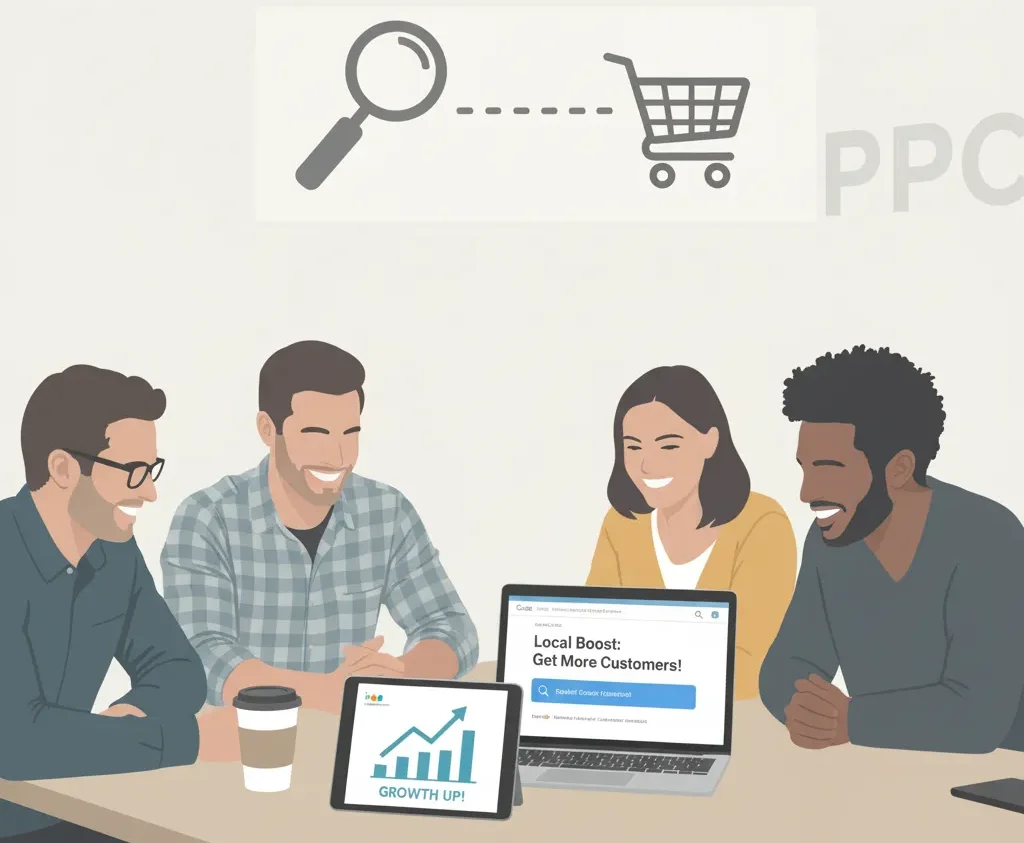- Understanding PPC and Its Benefits for Small Businesses
- Key benefits for small businesses:
- Developing a Robust Keyword Strategy
- Steps to build an effective keyword strategy:
- Using Geo-Targeting Effectively
- Benefits of geo-targeting:
- Creating Compelling Ads and Landing Pages
- Landing Page Best Practices:
- Leveraging Ad Extensions
- Monitoring, Testing, and Optimization
- Best practices:
- PPC Platforms for Small Businesses
- Common PPC Mistakes to Avoid
- Cost Considerations for Small Business PPC
- Finding Professional PPC Services
- . Real-World PPC Examples
- The Importance of Landing Pages
- Final Tips for Small Business PPC Success
Pay-per-click (PPC) advertising is one of the most effective ways for small businesses to reach highly targeted audiences, drive website traffic, and generate leads or sales. Unlike organic strategies, PPC Advertising for Small Businesses delivers immediate visibility, allowing small businesses to compete with larger companies on search engines, social media platforms, and other digital networks.
However, running a successful PPC campaign requires more than just setting a budget and launching ads. It involves strategic planning, precise targeting, creative ad development, and ongoing optimization. This guide covers everything you need to know to create, manage, and optimize PPC campaigns for your small business.

Understanding PPC and Its Benefits for Small Businesses
PPC Advertising for Small Businesses is a model where advertisers pay a fee each time someone clicks their ad. Google Ads, Microsoft Advertising (Bing), and Meta Ads (Facebook, Instagram) are the most common PPC platforms.
Key benefits for small businesses:
- Immediate visibility: Your ad appears at the top of search results, social feeds, or map listings.
- Targeted reach: Ads can be tailored by keywords, demographics, location, device, and user behavior.
- Measurable results: PPC platforms provide detailed analytics on clicks, impressions, conversions, and ROI.
- Cost control: You only pay when someone clicks your ad, and you can set daily or monthly limits.
Developing a Robust Keyword Strategy
Keywords are the foundation of any PPC campaign. Selecting the right ones ensures your ads reach potential customers actively searching for your products or services.
Steps to build an effective keyword strategy:
- Identify Your Target Audience
- Research demographics, interests, and online behavior.
- Understand their search intent: informational, navigational, or transactional.
- Analyze Competitors
- Use tools like SEMrush or Ahrefs to see which keywords drive traffic to competitors’ sites.
- Identify gaps and opportunities to target less competitive or underserved keywords.
- Use Keyword Research Tools
- Google Keyword Planner, Semrush, Ahrefs, and Ubersuggest provide search volume, competition level, and trend insights.
- Focus on Long-Tail Keywords
- Long-tail keywords are specific phrases that are less competitive and more likely to convert.
- Example: Instead of “plumber,” use “emergency plumbing services in Dallas.”
- Implement Negative Keywords
- Prevent ads from showing for irrelevant searches, ensuring budget efficiency.
- Regular Monitoring and Adjustment
- Track keyword performance, click-through rates (CTR), and conversion rates.
- Replace underperforming keywords and expand with new opportunities.
Using Geo-Targeting Effectively
For small businesses, geo-targeting is critical to reach customers within your operational area.
Benefits of geo-targeting:
- Higher relevance: Ads are shown to users in specific locations, increasing engagement.
- Optimized budget: Focus your spend on regions with the highest potential ROI.
- Local personalization: Customize offers and messaging for regional preferences.
Stats: 50% of mobile searches are location-based, and 61% of these local searches lead to a conversion (MarketSplash).
Creating Compelling Ads and Landing Pages
PPC Advertising for Small Businesses are the first impression of your business. Engaging ads combined with ad-relevant landing pages increase click-through rates and conversions.
Ad Copy Best Practices:
- Concise and relevant: Include targeted keywords aligned with search intent.
- Attention-grabbing: Highlight promotions, benefits, or unique selling points.
- Strong CTA: Clearly guide users to take action (“Book Now,” “Get a Quote,” “Sign Up Today”)
Landing Page Best Practices:
- Align with the ad copy for a seamless user experience.
- Clear, compelling headline and visual hierarchy.
- Fast loading speed and mobile optimization.
- Include strong CTAs and reduce distractions.
- Use social proof: testimonials, reviews, or trust badges.
Example: A barbershop ad should direct users to a page showing services, pricing, a booking form, and customer reviews—rather than a generic homepage.
Leveraging Ad Extensions
Ad extensions are optional elements that improve ad visibility and engagement. Types include:
- Sitelink Extensions: Direct users to specific pages like services or promotions.
- Call Extensions: Allow users to call your business directly from the ad.
- Location Extensions: Show your business address and directions.
- Price or Promotion Extensions: Highlight special deals or discounts.
Benefit: Ads with extensions often have higher CTRs and provide more information upfront, encouraging conversions.
Monitoring, Testing, and Optimization
Even the best PPC campaigns require ongoing adjustments to maximize ROI.
Best practices:
- Track Performance: Use Google Analytics, platform analytics, and EventTracker.
- A/B Testing: Test different headlines, ad copy, images, and CTAs.
- Budget Optimization: Increase bids for high-performing keywords and reduce spend on underperformers.
- Refine Targeting: Adjust audience, location, or device targeting based on performance data.
Pro Tip: Optimization is continuous—market trends, search behavior, and competition change, so stay proactive.
PPC Platforms for Small Businesses
Google Ads: Best for search, display, and video campaigns. Advanced targeting and analytics for precise control.
Microsoft Advertising (Bing Ads): Cost-effective option with integration to Bing search and Microsoft properties.
Meta Ads (Facebook & Instagram): Leverage the massive social audience with advanced demographic and behavioral targeting.
Tip: Each platform has unique advantages. Google Ads excels for intent-driven searches, while Meta Ads is ideal for brand awareness and social engagement.
Common PPC Mistakes to Avoid
- Ignoring keyword research: Leads to wasted budget on irrelevant clicks.
- Poor ad copy: Low CTR and unclear messaging reduce effectiveness.
- Sending traffic to homepage: Users need context-specific landing pages.
- Ignoring mobile users: Most searches happen on mobile; optimize for devices.
- Mismanaging budget: Overspending on low-converting ads limits ROI.
- Skipping analytics: Without tracking, optimization is impossible.
Cost Considerations for Small Business PPC
PPC costs vary by industry, competition, and location.
- Typical monthly budget: $1,000–$10,000
- Cost-per-click (CPC) depends on keyword competitiveness.
- Additional costs: campaign management, landing page optimization, tools/software subscriptions.
Proper planning and monitoring ensure you maximize ROI without overspending.
Finding Professional PPC Services
Small businesses can hire experts for PPC Advertising for through:
- Online directories: e.g., Digital Agency Network
- Freelance platforms: Fiverr, Upwork
- Industry-specific agencies: Agencies with experience in your sector
- Referrals: Recommendations from business peers
- Portfolio reviews: Case studies, client testimonials, past campaign results
. Real-World PPC Examples
- Google Search Ad – Barbershop Dallas, TX: Compelling headlines, ad extensions, and a dedicated booking landing page.
- Bing Maps Ad – Phoenix Auto Repair: Location-based targeting, direct phone contact, clear CTA on landing page.
- Bing Search Ad – Mitcham Veterinary Surgery: Keyword-targeted ad with strategic CTAs and appointment booking options.
Insight: Targeted ads with relevant landing pages, strong CTAs, and ad extensions drive the best results.
The Importance of Landing Pages
Landing pages turn clicks into conversions. Best practices include:
- Relevance: Match ad messaging and visitor intent.
- Clarity: Highlight benefits and guide users toward a single goal.
- A/B Testing: Optimize based on different audience segments.
Tools like Landingi can help small businesses create optimized, conversion-focused pages.
Final Tips for Small Business PPC Success

- Plan meticulously: Keyword strategy, geo-targeting, ad copy, and landing pages.
- Test continuously: Headlines, visuals, CTAs, and audiences.
- Monitor performance: Adjust budgets, bids, and targeting based on analytics.
- Stay updated: Keep up with platform updates, trends, and best practices.
With a strategic approach, small businesses can leverage PPC advertising to increase visibility, drive traffic, and generate leads efficiently.
Ready to Take Your Digital Marketing to the Next Level?
PPC Advertising for Small Businesses is just one piece of the digital marketing puzzle. To maximize your small business growth, it’s essential to understand the bigger picture—including SEO, content marketing, social media, email marketing, and more.
Dive deeper into a complete strategy for small businesses with our Ultimate Guide to Digital Marketing for Small Businesses. Learn how to integrate PPC with other channels, optimize your campaigns, and drive long-term growth.
Start mastering digital marketing today and watch your business thrive!

